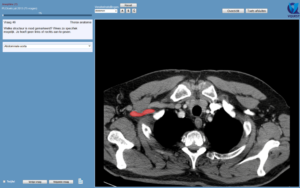Using VQuest allows for realistic testing of candidates and determine the level of image interpretation skill.
VQuest offers similar image manipulation tools as a clinical workstation. Specialists continuously use two and three-dimensional digital images of the human body. They scroll through the stack of slices in any direction, change the viewing direction and adapt the window-level setting (contrast). Using VQuest, students learn how to interpret an image in a similar way. This way of testing has proven to be highly authentic and is close to daily practice in a hospital.
FEED-IT: combining VQuest with a Visual Learning Analytics Dashboard
With a grant from the Open & Online SURF project we aimed to teach medical students to better interpret medical (radiological) images. For this purpose, an e-learning module has been developed, which is embedded in the teaching of medical students in the University Medical Center Utrecht, the Netherlands. By actively working with questions and feedback, the intensity of the training is increased and the teachers are better prepared for the on-site group-based practicum.
The results have been presented at AMEE 2024 (Basel) in a short communication. The video on demand can be viewed here:
X-games
With a grant from the SURF foundation we have developed an online serious game to stimulate both motivation and learning activity for the training of image interpretation skills with volumetric data (e.g. CT-series). Currently, the game is only availaible in Dutch. You can create your own account and play the game by going to learningwithimages.com.
VQuest instruction movie
In this brief movie, we explain some basic concepts of working with VQuest (scrolling, changing viewing direction, answering questions).



